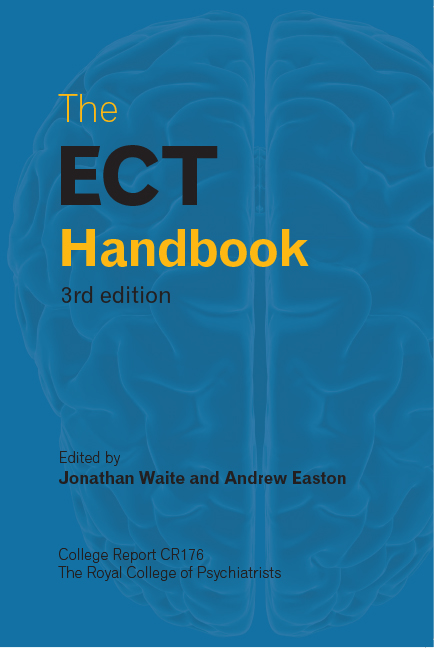Book contents
- Frontmatter
- Contents
- Abbreviations
- List of figures, tables and boxes
- List of contributors
- Preface
- Introduction: the role of ECT in contemporary psychiatry: Royal College of Psychiatrists’ Special Committee on ECT and Related Treatments
- 1 Mechanism of action of ECT
- 2 The ECT suite
- 3 Anaesthesia for ECT
- 4 ECT prescribing and practice
- 5 Psychotropic drug treatment during and after ECT
- 6 Monitoring a course of ECT
- 7 Non-cognitive adverse effects of ECT
- 8 Cognitive adverse effects of ECT
- 9 Dental issues related to ECT
- 10 Training, supervision and professional development: achieving competency
- 11 Nursing guidelines for ECT
- 12 Inspection of ECT clinics
- 13 Other brain stimulation treatments
- 14 The use of ECT in the treatment of depression
- 15 The use of ECT in the treatment of mania
- 16 The use of ECT in the treatment of schizophrenia and catatonia
- 17 The use of ECT in neuropsychiatric disorders
- 18 The use of ECT in people with intellectual disability
- 19 Safe ECT practice in people with a physical illness
- 20 ECT for older adults
- 21 The use of ECT as continuation or maintenance treatment
- 22 Consent, capacity and the law
- 23 Patients’ and carers’ perspectives on ECT
- Appendix I Out-patient declaration form
- Appendix II ECT competencies for doctors
- Appendix III Example of a job description for an ECT nurse specialist
- Appendix IV Example of a job description for an ECT nurse/ECT coordinator
- Appendix V Information for patients and carers
- Appendix VI Example of a consent form
- Appendix VII Useful contacts
- Appendix VIII Example of a certificate of incapacity
- Index
Preface
- Frontmatter
- Contents
- Abbreviations
- List of figures, tables and boxes
- List of contributors
- Preface
- Introduction: the role of ECT in contemporary psychiatry: Royal College of Psychiatrists’ Special Committee on ECT and Related Treatments
- 1 Mechanism of action of ECT
- 2 The ECT suite
- 3 Anaesthesia for ECT
- 4 ECT prescribing and practice
- 5 Psychotropic drug treatment during and after ECT
- 6 Monitoring a course of ECT
- 7 Non-cognitive adverse effects of ECT
- 8 Cognitive adverse effects of ECT
- 9 Dental issues related to ECT
- 10 Training, supervision and professional development: achieving competency
- 11 Nursing guidelines for ECT
- 12 Inspection of ECT clinics
- 13 Other brain stimulation treatments
- 14 The use of ECT in the treatment of depression
- 15 The use of ECT in the treatment of mania
- 16 The use of ECT in the treatment of schizophrenia and catatonia
- 17 The use of ECT in neuropsychiatric disorders
- 18 The use of ECT in people with intellectual disability
- 19 Safe ECT practice in people with a physical illness
- 20 ECT for older adults
- 21 The use of ECT as continuation or maintenance treatment
- 22 Consent, capacity and the law
- 23 Patients’ and carers’ perspectives on ECT
- Appendix I Out-patient declaration form
- Appendix II ECT competencies for doctors
- Appendix III Example of a job description for an ECT nurse specialist
- Appendix IV Example of a job description for an ECT nurse/ECT coordinator
- Appendix V Information for patients and carers
- Appendix VI Example of a consent form
- Appendix VII Useful contacts
- Appendix VIII Example of a certificate of incapacity
- Index
Summary
Since the last edition of The ECT Handbook was published there have been three important developments: the implementation of accreditation services for ECT clinics, revision of the mental health legislation and the publication of the National Institute for Health and Clinical Excellence (NICE) guidance on the management of depression that significantly amends the recommendations on the use of ECT in depressive disorders.
The ECT Accreditation Service (ECTAS) and the Scottish ECT Accreditation Network (SEAN) had been planned at the time of the last handbook; they are now firmly established as a means of ensuring enhancing the standards of clinical practice in ECT in member clinics. Participating in the accreditation process has led nurses working in ECT to develop their own networks: the Committee of Nurses at ECT in Scotland (CONECTS) and the National Association of Lead Nurses in ECT (NALNECT) in other parts of the UK. Progressive cycles of ECTAS peer review have been successful in improving levels of performance by member clinics.
In Britain, the 2007 amendments of the Mental Health Act 1983 and the Mental Health (Care and Treatment) Act (Scotland) 2003 have changed the legal framework for patients who do not or cannot consent to ECT; patients with capacity who refuse ECT may not be given the treatment contrary to their objections. There is also new legislation on mental health treatment in Ireland (Mental Health Commission, 2009 a,b) and the law in Northern Ireland in being revised.
The NICE (2009) guidelines for the treatment and management of depression in adults include revised recommendations of the use of ECT in depressive illness. The Royal College of Psychiatrists’ Special Committee on ECT welcomes and endorses this new guidance.
The Special Committee on ECT and Related Treatments, like NICE, has reversed its previous recommendation in favour of routine adoption of unilateral electrode placement. New evidence from an adequately powered, methodologically sound study (Kellner et al, 2010) has allowed reconsideration of the balance between maximising the benefit of ECT and minimising adverse cognitive effects. The Committee now feels that for most patients receiving ECT in Britain, treatment should start with bitemporal electrode placement.
- Type
- Chapter
- Information
- The ECT Handbook , pp. x - xiPublisher: Royal College of PsychiatristsFirst published in: 2017



